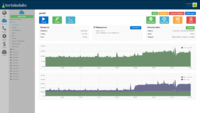I would like to point out that there is a free, open-source commercial-friendly panel that has existed for some time.
Cloudware is the latest generation of virtualization orchestration done by myself and my team. We are the team that built all of the technical innovations behind the RapidXen product (and before that the SIP:GRID product series) a few years ago. We are running this software in production without issue since launching a new virtualization business earlier this year.
The big difference between Cloudware and the other panels discussed here is simple: Cloudware is a product you can deploy right now for free.
Security
In Cloudware, panel to node communications are done over a proprietary transport which has been used without trouble for almost a decade.
Nodes implement a strict subset of APIs and there is no API call available for executing an arbitrary command. Beyond this, the management agent running on the node uses POSIX execv() calls instead of invoking the system shell and only calls executables written in C or Python. Absolutely no shell scripting vulnerabilities are possible under our model.
There is no bullshit claims about "7 layers of authentication." There is simply a shared keyring with PBKDF2-based signature derivation on the API requests. The nodes will respond to whatever has the appropriate secret keys. Otherwise, they will be rejected.
User Experience
The attached screenshot shows what the user sees when she wishes to manage one of her VPS. The user is able to manage her VPS via a rescue console using WebSockets, as well. The websockets service has some other APIs available as well, such as statistics collection for real-time profiling.
This screenshot represents the build we are running as of 10 minutes ago. We are working to add additional features to the user experience, too.
In my opinion, it makes SolusVM and OnApp look like jokes.
If you're interested in the code, you can get it all from http://bitbucket.org/tortoiselabs.

Cloudware is the latest generation of virtualization orchestration done by myself and my team. We are the team that built all of the technical innovations behind the RapidXen product (and before that the SIP:GRID product series) a few years ago. We are running this software in production without issue since launching a new virtualization business earlier this year.
The big difference between Cloudware and the other panels discussed here is simple: Cloudware is a product you can deploy right now for free.
Security
In Cloudware, panel to node communications are done over a proprietary transport which has been used without trouble for almost a decade.
Nodes implement a strict subset of APIs and there is no API call available for executing an arbitrary command. Beyond this, the management agent running on the node uses POSIX execv() calls instead of invoking the system shell and only calls executables written in C or Python. Absolutely no shell scripting vulnerabilities are possible under our model.
There is no bullshit claims about "7 layers of authentication." There is simply a shared keyring with PBKDF2-based signature derivation on the API requests. The nodes will respond to whatever has the appropriate secret keys. Otherwise, they will be rejected.
User Experience
The attached screenshot shows what the user sees when she wishes to manage one of her VPS. The user is able to manage her VPS via a rescue console using WebSockets, as well. The websockets service has some other APIs available as well, such as statistics collection for real-time profiling.
This screenshot represents the build we are running as of 10 minutes ago. We are working to add additional features to the user experience, too.
In my opinion, it makes SolusVM and OnApp look like jokes.
If you're interested in the code, you can get it all from http://bitbucket.org/tortoiselabs.

